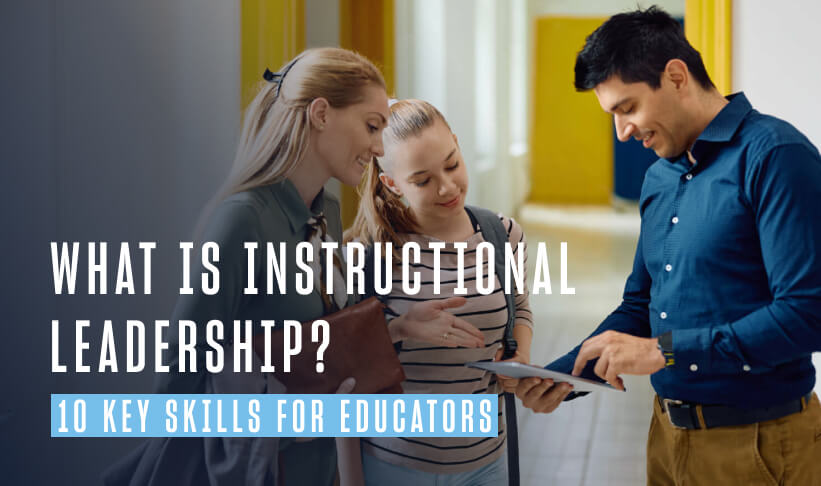Historically, school principals have been perceived as top-down authority figures primarily responsible for managerial and political aspects of education. However, the U.S. educational landscape is evolving, and with it, the role of instructional leaders. Today, the role of school leaders is shifting toward fostering a holistic culture of learning for everyone, motivating both students and teachers to reach higher levels of achievement.
In this article, we delve into the intricacies of instructional leadership, highlighting the critical role it plays in shaping the future of education and empowering leaders to facilitate academic excellence.
What Is Instructional Leadership?
Instructional leadership is a multifaceted concept that describes the responsibilities of a K–12 school principal. Also called pedagogical leadership, learning-centered leadership, leadership for learning or student-centered leadership — strong instructional leadership is at the heart of educational excellence. Today, this form of leadership transcends the traditional administrative roles of school principals, encompassing a broader perspective that advocates for the ongoing development of teaching and learning.
Rather than serve in a siloed managerial or political capacity, instructional leaders are increasingly expected to distribute the weight of a school’s responsibilities more equitably to prioritize student success. Their day-to-day tasks can include managing curriculums, budgets and scheduling, as well as demonstrating a model of teamwork that students and educators can emulate. Instructional leaders also strive to empower teachers to become leaders themselves, fostering an environment of continuous improvement.
While school principals are the most common example of instructional leaders, the concept also extends to positions such as department heads, program directors, academic advisors, academic deans and more.
Brief History of Instructional Leadership
The current understanding of instructional leadership emerged in the 1970s through the pioneering work of educator Ronald Edmonds. He demonstrated that school leaders who actively focus on learning (rather than solely administrative duties) have a profound impact on student learning outcomes, challenging the notion that teaching is solely the teachers’ domain.
This leadership approach gained popularity in the 1980s and ‘90s and continues to evolve. Substantial research — including works by educational researchers such as Kenneth Leithwood, Viviane Robinson and Jason A. Grissom — consistently shows that instructional leadership significantly enhances student learning outcomes, offering compelling evidence across educational contexts.
What Does an Instructional Leader Do?
The specifics of an instructional leader’s duties and responsibilities depend on their particular role in an educational setting. Whether they are a school principal, department head or curriculum advisor, instructional leaders are broadly responsible for:
- Developing (or helping to develop) teaching and learning objectives
- Collaborating with other educators on ways to enhance student learning
- Clearly communicating expectations to students and teachers
- Mentoring other educators
- Encouraging and supporting professional development for teachers
- Advocating for and protecting teachers’ instructional time
- Monitoring student progress
- Coordinating the curriculum
- Providing instructional support as needed
Depending on their role, instructional leaders may also handle administrative tasks such as scheduling, budgeting, communications and coordinating meetings.
It should also be noted that instructional leadership is not always limited to one person. Rather, a network of educational professionals can propose, inform, manage and execute various leadership initiatives.
Examples of Instructional Leadership Roles
According to Indeed, the following roles typically execute instructional leadership in some capacity.
- Principal: The school’s top administrator responsible for high-level leadership, managing staff, students, program implementation and school operations.
- Assistant Principal: Assists the principal in school leadership, often focusing on specific aspects of school administration, such as discipline or communications.
- Department Chair: A faculty member who oversees a specific academic department, coordinating the curriculum and mentoring fellow educators.
- Athletic Director: Manages a school’s extracurricular sports programs, handling scheduling, facilities and compliance with athletic and school regulations.
- Academic Dean: Typically a higher education role responsible for academic program oversight, faculty support and curriculum development.
- Curriculum Manager: Oversees the development and implementation of educational curricula in schools or other educational institutions.
- Curriculum Developer: Designs and creates educational materials and curriculum content for various levels of education, often under a curriculum manager.
- Education Program Manager: Manages educational programs, ensuring they align with objectives, budgets, standards and school regulations.
- Academic Advisor: Provides guidance to students regarding their academic and career goals, course selection and educational planning.
- Assessment Specialist: Develops and administers tests and assessments to evaluate student learning and educational program effectiveness.
10 Skills Required for Instructional Leadership
Effective instructional leadership requires a set of skills that directly impact both teacher and student success. Ideal key skills include:
- Communication skills (verbal and written): The ability to convey ideas, expectations and feedback clearly through spoken and written communication.
- Planning ability: Creating and implementing effective, strategic plans for educational improvement.
- Team building/collaboration: The ability to build effective teams, foster collaboration among staff and work toward common goals.
- Delegation: Effectively assigning responsibilities and tasks to the right individuals or teams, ensuring an equitable distribution of work.
- Trustworthiness: Establishing a reputation for honesty and reliability to build trust with teachers, students and caregivers.
- Objectivity: Making decisions based on a fair and impartial assessment of situations and issues, without bias.
- Active listening skills: Actively engaging in conversations to understand the needs and concerns of teachers, students and their guardians.
- Competence: Demonstrating proficiency and expertise of necessary skills and knowledge.
- Transparency: Openly sharing information and decisions, promoting trust and clarity.
- Positive attitude: Maintaining an optimistic and supportive demeanor to inspire and motivate others.
Using these skills, instructional leaders can:
- Inspire action and optimism, motivating and mobilizing staff and students to take positive actions to improve their educational experience.
- Lead by example by modeling fairness, honesty and integrity, treating all individuals with respect.
- Provide guidance and support to teachers, students and guardians, creating a supportive environment both inside and beyond the school walls.
- Establish connections with parents and caregivers, involving them in their students’ learning and school initiatives.
- Inspire others to set both individual and collective goals that contribute to the overall success of the school or institution.
- Promote shared leadership by establishing networks of influence to delegate responsibilities within and across schools.
- Encourage individuals in non-leadership roles to contribute to institutional decisions.
- Gather feedback, solicit ideas and make informed decisions using objective assessment.
- Ensure that teachers have clear direction and the necessary educational resources to enhance their instruction.
- Research, identify and implement the resources needed to improve the learning environment.
RELATED READING: 10 Traits of Successful School Leaders >>
Impact of Instructional Leadership
According to researcher Viviane Robinson, there are five key leadership practices that significantly enhance student learning:
- Establishing clear goals and expectations
- Strategic resourcing
- Ensuring quality teaching
- Leading and supporting teacher learning and development
- Maintaining an orderly and safe learning environment
If executed well by leaders, these practices have a profound impact on student learning and achievement. An instructional leader’s job is to implement strategies that directly affect what happens within classrooms, deploying processes and tools that will hopefully foster a positive learning culture and a conducive environment for effective teaching. Strong instructional leadership is also associated with coherence in educational practices, increased teacher collaboration and reduced teacher isolation.
Instructional leaders often connect teachers to critical resources beyond educational tools, such as mental health support, and safeguard their planning and break time to mitigate stress and burnout.
Tips for Effective Instructional Leadership
School leadership is no longer relegated to a principal acting as a top-down authority figure; rather, school leadership is a holistic, collaborative and iterative process, often involving more than one person. Nor is leadership an innate quality — the skill of leadership can be learned and practiced, just like any other skill.
If you are an educator seeking ways to grow in an instructional leadership role, consider the following tips for success:
- Communicate a clear vision: Articulate an explicit and inspiring vision for your school or district with specific goals that guide the educational mission. Ensure that all stakeholders understand and embrace this vision.
- Establish realistic expectations: As a part of attaining this vision, set clear, reasonable expectations for teachers, always accounting for their capacity and the resources available.
- Conduct regular classroom observations: Regularly observe classroom activities to gain insight into teaching and learning practices. Provide constructive feedback to help teachers enhance their instructional methods (always after class is over, and never in front of students!).
- Understand various teaching and learning styles: Familiarize yourself with various teaching and learning styles so that you can better support teachers and students in adapting to individual preferences and needs.
- Recognize strengths and achievements: Recognize and appreciate the unique strengths of both students and teachers, and provide opportunities for them to leverage their talents for the benefit of the school community.
- Provide feedback and praise: Offer teachers constructive feedback in a positive way to encourage professional growth.
- Maintain clear communication: Foster open and frequent communication with teachers to create a supportive and collaborative environment. Address concerns promptly and provide a platform for sharing ideas and feedback.
- Track student achievement: Implement systems for tracking and analyzing student achievement data. Assist teachers in interpreting this data to make informed decisions and adjustments to their instructional practices.
- Encourage professional development: Promote ongoing professional development for teachers to enhance their skills and stay updated with the latest educational trends and methodologies.
- Model supportive leadership: Lead by example by teaching a class or substituting for an absent teacher when needed. This hands-on approach demonstrates your commitment to (and knowledge of) the educational process.
- Never stop learning: Continuously seek opportunities for your own development and growth through conferences, trainings and continuing education. Stay informed about best practices and the latest developments in education.
Effective instructional leadership not only fosters a positive learning environment but also empowers teachers and students to reach their full potential, ultimately contributing to the overall success of the school.
Helping Educators Become Leaders at USD
The Master of Education (MEd) program at the University of San Diego (USD) offers a School Leadership specialization, tailored specifically to seasoned K–12 educators with goals of assuming leadership roles in their schools and communities. This specialization is built around a five-course sequence focusing on fundamental aspects of school leadership, including:
- Data-driven decision-making: Collecting, analyzing and utilizing student data to inform and enhance educational practices.
- Instructional leadership: Preparing to lead and support effective teaching and learning initiatives within school communities.
- Professional learning communities: Fostering collaborative learning environments that promote professional growth among educators.
- Meaningful engagement with families and communities: Encouraging the development of strong relationships between schools and their communities, recognizing the significance of external stakeholders.
- Ethical and professional norms: Addressing the ethical and professional standards expected of educational leaders.
Upon completing the MEd in School Leadership program, graduates are equipped to take required examinations or performance-based assessments mandated by their respective states for administrative credentials.
These courses — like many leadership courses at USD — are firmly grounded in a social justice foundation, emphasizing the importance of culturally responsive leadership and empowering educators to advance equity and excellence in their schools and communities.




